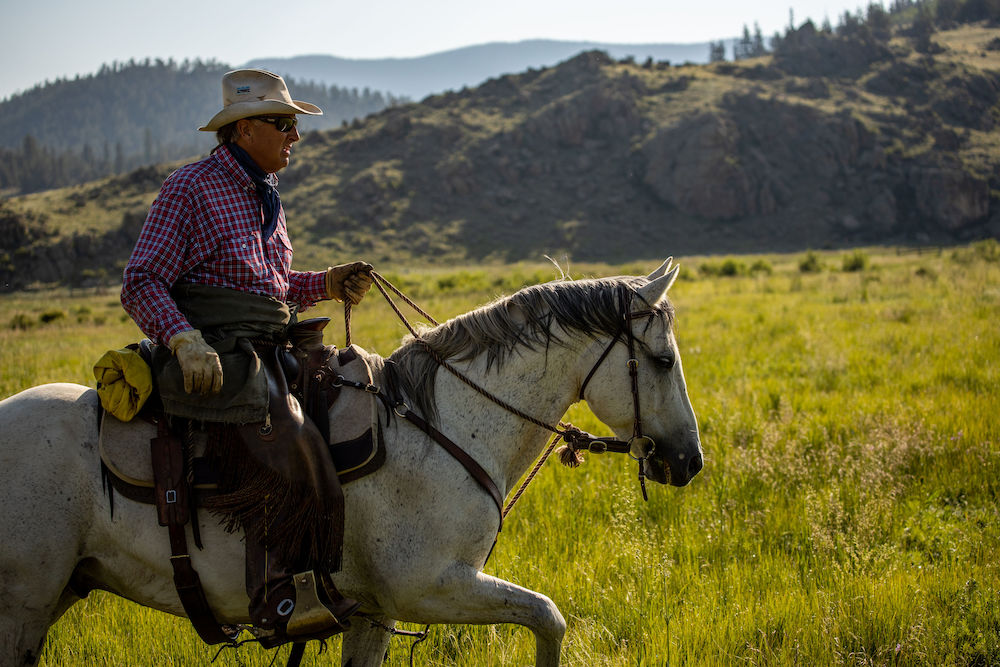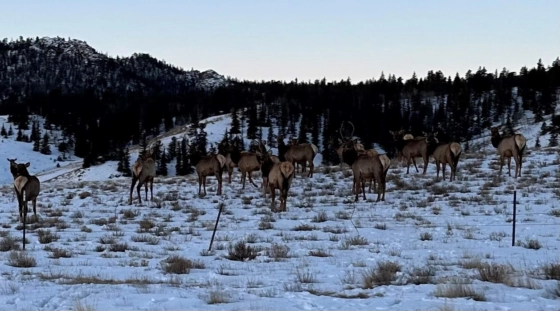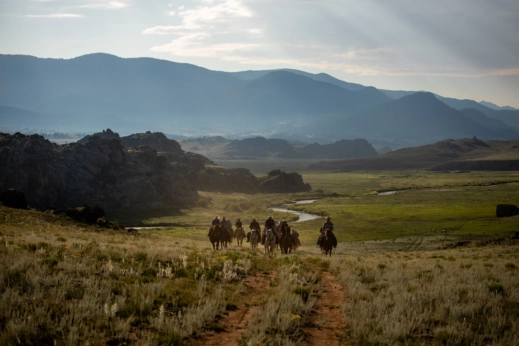Meet the Ranchers Working to Sustain the World’s Largest Elk Population
At this Colorado ranch, elk are a benefit.
Meet the Ranchers Working to Sustain the World’s Largest Elk Population
At this Colorado ranch, elk are a benefit.

Dave Gottenborg on his ranch in Jefferson, Colorado.courtesy of Eagle Rock Ranch.
At Eagle Rock Ranch in Jefferson, Colorado, the elk start to gather at dusk. “I’ll be driving up the road, and the herd will be on the side, almost like they’re waiting to come and spend the night eating here,” says Dave Gottenborg with a chuckle.
Gottenborg is working to create a habitat on his ranch that sustains the elk population. The ranch sits on the migratory path of the big animals, and every winter, hundreds of them travel through Eagle Rock looking for food as they move from higher to lower elevations. You could see their presence as a wildlife management success story or a nuisance, depending on how you look at them. Maybe a bit of both.
“Elk can provide an indicator of how well habitats are functioning,” says Karie Decker, director of wildlife and habitat for the Rocky Mountain Elk Foundation, which works to ensure the animals have the habitat they need to thrive. “They have a direct role on vegetation through herbivory and seed dispersal, create wallows and serve as prey and carrion for many other wildlife species.”
According to the Rocky Mountain Elk Foundation, before Europeans settled in North America, more than 10 million elk were roaming around the US and parts of Canada, but due to overhunting and habitat loss, their numbers dwindled to 40,000 at the turn of the 20th century.
That’s when conservationists and government agencies began efforts to restore elk populations through protected areas and regulated hunting. Today, Colorado is home to 280,000 elk, the biggest population in the world. Despite these efforts, maintaining that population is a challenge.

Threats to the elk include everything from climate change to manufactured barriers that can stifle their daily and seasonal movements, land development, traffic, increased human recreational activity, fencing and conflicts with human activities.
“In Colorado, elk and many other species had a very challenging winter in 2022-2023, with a deep snowpack for an extended period, significantly reducing the population in northwest Colorado,” says Decker. “Other challenges to elk across various states include development and the loss of habitat, lack of or low-quality forage, drought, disease and social tolerance.”
Eagle Rock Ranch has been in operation, primarily as a cow-calf operation, for more than 150 years, but Gottenborg, who runs the ranch with his wife, Jean Gottenborg, daughter Erin Michalski and son-in-law Matt Michalski, is relatively new to Eagle Rock, acquiring the ranch about 12 years ago. The elk came with it.
“My predecessor fought them for years,” says Gottenborg. “He did probably everything a landowner could legally do to chase elk off the property, with mixed results. He had propane cannons and salt and pepper shells, and he would get into these big arguments with the Forest Service and CPW [Colorado Parks and Wildlife].”

Elk are not small visitors. Males can weigh up to 700 pounds and stand five feet at the shoulder, females up to 500 pounds and 4-1/2 feet at the shoulder.
“They are very large, determined eaters,” says Kara Van Hoose, Northeast Region public information officer for CPW. “They will devour hay and other grains left outside for domestic animals and livestock. Elk are known to be destructive in their pursuit of food, toppling over containers, ruining fences and other infrastructure and eating large swaths of crops.”
Still, the Gottenborgs decided to welcome the elk, hoping to make them a benefit to the ranch. Since buying the ranch, the Gottenborgs have been working to diversify their income with the goal of keeping themselves and other ranchers on the land and maintaining the open landscapes. They’ve dipped their toes into agritourism with curated experiences, including fly fishing, ranch tours and eco-tours, and they see the elk as another income stream.
Programs such as Elk Rent in Montana, from the nonprofit Property and Environment Research Center, and the USDA’s Migratory Big Game Initiative in Wyoming, Idaho and Montana pay landowners for providing elk habitat. While there isn’t a program set up yet to do the same in Colorado, the Gottenborgs are in talks with organizations that will pay for the elk to have forage access to their pastures in the winter.
During the winter months when the elk are migrating through the property, the Gottenborgs’ cattle are in Nebraska, so the Gottenborgs don’t need to worry about cows and elk competing for food. By the time the cows are back on the ranch, the elk have moved back up to higher ground. To make it easier for the elk to graze without the risk of getting caught in their fences, they’ve started making modifications to make it easier for them to move up and down the valley.
“The hope here, too, is that my neighbors are watching me. That they’re following what we’re doing and we can expand the concept, so, eventually, there’s 10 or 12 miles of this valley opened up in terms of easier access,” says Gottenborg.

Elk-friendly fencing that can be laid down flat on the ground to support seasonal wildlife passage is expensive. Still, the Gottenborgs believe there is enough interest in the forage access that they’ll be able to make more modifications. They’re not laying down all of the fences, but they can easily track the migration patterns of the elk in the snow, so they lay down specific fencing sections while keeping their gates open.
In 2023, the Gottenborgs also installed five large, shallow-pool structures that hold fresh water with pumps powered by solar panels. The drinkers, as the Gottenborgs call them, provide water in the higher elevation pastures during the warmer months and the shoulder seasons where natural water sources aren’t present and help to distribute wildlife across the landscape better. They’re hoping to install additional drinkers this year.
“The elk have been here a long time, and we’re trying to change our approach to make them an asset,” says Gottenborg.
Follow us
This work is licensed under a Creative Commons Attribution-NoDerivatives 4.0 International License.
Want to republish a Modern Farmer story?
We are happy for Modern Farmer stories to be shared, and encourage you to republish our articles for your audience. When doing so, we ask that you follow these guidelines:
Please credit us and our writers
For the author byline, please use “Author Name, Modern Farmer.” At the top of our stories, if on the web, please include this text and link: “This story was originally published by Modern Farmer.”
Please make sure to include a link back to either our home page or the article URL.
At the bottom of the story, please include the following text:
“Modern Farmer is a nonprofit initiative dedicated to raising awareness and catalyzing action at the intersection of food, agriculture, and society. Read more at <link>Modern Farmer</link>.”
Use our widget
We’d like to be able to track our stories, so we ask that if you republish our content, you do so using our widget (located on the left hand side of the article). The HTML code has a built-in tracker that tells us the data and domain where the story was published, as well as view counts.
Check the image requirements
It’s your responsibility to confirm you're licensed to republish images in our articles. Some images, such as those from commercial providers, don't allow their images to be republished without permission or payment. Copyright terms are generally listed in the image caption and attribution. You are welcome to omit our images or substitute with your own. Charts and interactive graphics follow the same rules.
Don’t change too much. Or, ask us first.
Articles must be republished in their entirety. It’s okay to change references to time (“today” to “yesterday”) or location (“Iowa City, IA” to “here”). But please keep everything else the same.
If you feel strongly that a more material edit needs to be made, get in touch with us at [email protected]. We’re happy to discuss it with the original author, but we must have prior approval for changes before publication.
Special cases
Extracts. You may run the first few lines or paragraphs of the article and then say: “Read the full article at Modern Farmer” with a link back to the original article.
Quotes. You may quote authors provided you include a link back to the article URL.
Translations. These require writer approval. To inquire about translation of a Modern Farmer article, contact us at [email protected]
Signed consent / copyright release forms. These are not required, provided you are following these guidelines.
Print. Articles can be republished in print under these same rules, with the exception that you do not need to include the links.
Tag us
When sharing the story on social media, please tag us using the following: - Twitter (@ModFarm) - Facebook (@ModernFarmerMedia) - Instagram (@modfarm)
Use our content respectfully
Modern Farmer is a nonprofit and as such we share our content for free and in good faith in order to reach new audiences. Respectfully,
No selling ads against our stories. It’s okay to put our stories on pages with ads.
Don’t republish our material wholesale, or automatically; you need to select stories to be republished individually.
You have no rights to sell, license, syndicate, or otherwise represent yourself as the authorized owner of our material to any third parties. This means that you cannot actively publish or submit our work for syndication to third party platforms or apps like Apple News or Google News. We understand that publishers cannot fully control when certain third parties automatically summarize or crawl content from publishers’ own sites.
Keep in touch
We want to hear from you if you love Modern Farmer content, have a collaboration idea, or anything else to share. As a nonprofit outlet, we work in service of our community and are always open to comments, feedback, and ideas. Contact us at [email protected].by Bridget Shirvell, Modern Farmer
March 8, 2024
Modern Farmer Weekly
Solutions Hub
Innovations, ideas and inspiration. Actionable solutions for a resilient food system.
ExploreExplore other topics
Share With Us
We want to hear from Modern Farmer readers who have thoughtful commentary, actionable solutions, or helpful ideas to share.
SubmitNecessary cookies are absolutely essential for the website to function properly. This category only includes cookies that ensures basic functionalities and security features of the website. These cookies do not store any personal information.
Any cookies that may not be particularly necessary for the website to function and are used specifically to collect user personal data via analytics, ads, other embedded contents are termed as non-necessary cookies.
Wonderful wildlife news for a change!
Thank you for helping God’s elk, deer, etc. I have been a avid hunter, fisher- woman, mountain climber, outdoors woman and raised my 2 daughters by myself, to love all wilderness type activities. I taught them you don’t shoot/kill a animal unless you are putting it in the freezer! It was game meat that sustained us all of their childhoods. I want to say I really appreciate you’al taking care of wildlife! It seems its always been farmers/ranchers vs. Wildlife. I hope you can teach others to do the same for our wildlife. I had to give up all that… Read more »
It will be ranchers like you to lead the way for others to learn to co-exist with all types of wildlife that need their ancestorial lands before humans. There are ways to live and for your ranch to thrive. Without ranching, these lands would be destroyed with houses and shopping centers. Thank you for what you’re doing!
Fabulous article 💕